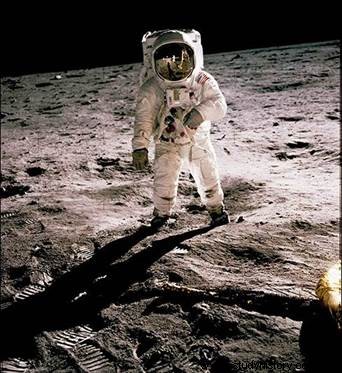 July 20, 1969 at 9:56 p.m. Houston time, a crew consisting of Neil Armstrong (Mission Commander) and Edwin “Buzz” Aldrin (lunar module pilot) lands on the Moon after a 3-day trip, while Michael Collins remained in orbit in the command module in preparation for the return trip. A few hours later, July 21, 1969 , the time to put on his space suit integrating an autonomous survival system, and Armstrong becomes the first man to walk on the Moon . He thus realizes the crazy promise made eight years earlier by President John F. Kennedy during his May 25, 1961 speech to the United States Congress.
July 20, 1969 at 9:56 p.m. Houston time, a crew consisting of Neil Armstrong (Mission Commander) and Edwin “Buzz” Aldrin (lunar module pilot) lands on the Moon after a 3-day trip, while Michael Collins remained in orbit in the command module in preparation for the return trip. A few hours later, July 21, 1969 , the time to put on his space suit integrating an autonomous survival system, and Armstrong becomes the first man to walk on the Moon . He thus realizes the crazy promise made eight years earlier by President John F. Kennedy during his May 25, 1961 speech to the United States Congress.
The space race in the 50s and early 60s
The USA has just succeeded in one of the greatest feats of humanity and finally concretizes its technological superiority over the USSR in the space field, hard won at the cost of an "astronomical" financial commitment (150 billion current dollars) and a "pharaonic" human mobilization (nearly 400,000 people directly or indirectly involved in the program). A look back, 50 years later, on an event that had a lasting impact on an entire generation.
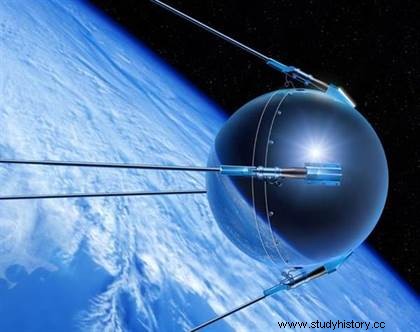 The completely crazy project to send man to the moon is part of a fierce competition between the United States and the USSR and in the midst of the Cold War . The mastery of space then appears as a major issue for these two great post-World War II superpowers, mainly from a military and geostrategic point of view, but also as a formidable vector of propaganda making it possible to show the whole world that " its polity" is superior to that of the enemy since it enables its citizens to accomplish greater exploits.
The completely crazy project to send man to the moon is part of a fierce competition between the United States and the USSR and in the midst of the Cold War . The mastery of space then appears as a major issue for these two great post-World War II superpowers, mainly from a military and geostrategic point of view, but also as a formidable vector of propaganda making it possible to show the whole world that " its polity" is superior to that of the enemy since it enables its citizens to accomplish greater exploits.
In the 1950s and until the mid-1960s, this space race was unquestionably dominated by the Russians, who dealt the Americans humiliation upon humiliation:the launch of the first satellite (Sputnik , October 4, 1957), the first man to fly in space and in orbit around the earth (Yuri Gagarin , April 12, 1961), the first spacewalk (Alexei Leonov , March 18, 1965), the first probe to land smoothly on the Moon (Luna 9 , February 3, 1966). Despite his efforts, NASA led by Wernher Von Braun only manages to painfully follow the shadow of the other astronautical genius of the moment, Sergei Korolev . The latter, if he cannot count on the elite of the German scientists of the Nazi V1 and V2 rocket program (who joined Von Braun) but only on a contingent of second choice, nevertheless manages to establish his domination thanks to to his strength of character, his visionary genius, and his great talents as an organizer.
Kennedy and the bet to put the first man on the moon
In the early 1960s, the snub of the aborted Bay of Pigs landings significantly damaged the image of the United States in the eyes of the world. At the same time, the launch of the first man into space by the Soviets dealt a new blow to the American space program, which then did not benefit from sufficient means and know-how to reverse the trend. This situation convinced President John F. Kennedy of the need for a large-scale space program which should enable him to recover the lost international prestige.
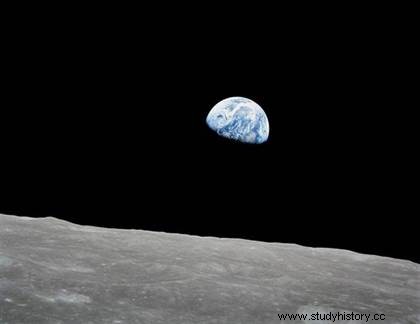 He then asks his Vice President Lyndon B. Johnson to offer him an ambitious objective allowing him to regain the upper hand over the Soviet Union. This is how the objective of sending a manned mission to the Moon before the end of the decade was announced before the United States Congress on May 25, 1961, then confirmed during a now legendary second speech on September 12. 1962:"We choose to go to the Moon "... The political and civil support is total, and NASA quickly sees its annual budget multiplied... by ten!
He then asks his Vice President Lyndon B. Johnson to offer him an ambitious objective allowing him to regain the upper hand over the Soviet Union. This is how the objective of sending a manned mission to the Moon before the end of the decade was announced before the United States Congress on May 25, 1961, then confirmed during a now legendary second speech on September 12. 1962:"We choose to go to the Moon "... The political and civil support is total, and NASA quickly sees its annual budget multiplied... by ten!
The Apollo program:a technological, organizational and financial challenge
The challenge of getting to the moon and coming back alive is dizzying. First, the delay announced by Kennedy seems totally insurmountable to most specialists. Beyond the colossal financial means that had to be committed, this new objective required the development of new technologies, know-how and infrastructures which were for the most part totally non-existent at the time. The choice of method has hardly been studied so far:the choice must be between sending a single, complete ship directly to the Moon (which requires a Nova rocket dimensions and titanic power), the organization of an orbital rendezvous around the earth to assemble the said vessel (which limits the risks and costs), or the rendezvous in lunar orbit (which requires maneuvers complex such as rendezvous between spacecraft). It is ultimately this last scenario that is retained because it is the only one that can be implemented "before the end of the decade".
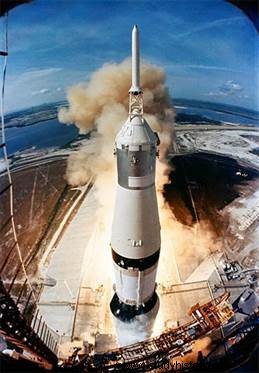 Although this scenario is the least demanding in terms of propulsion power, the rocket that must allow the sending men on the moon does not yet exist. The future rocket Saturn V must indeed provide a power 100 times greater than the Mercury-Redstone who propelled Alan Shepard in suborbital flight in 1961. Incidentally, the liquid hydrogen engines needed to lift such a monster have not yet been developed. It should be noted that the Saturn 5 remains to this day, and by far, the largest and most powerful rocket ever built.
Although this scenario is the least demanding in terms of propulsion power, the rocket that must allow the sending men on the moon does not yet exist. The future rocket Saturn V must indeed provide a power 100 times greater than the Mercury-Redstone who propelled Alan Shepard in suborbital flight in 1961. Incidentally, the liquid hydrogen engines needed to lift such a monster have not yet been developed. It should be noted that the Saturn 5 remains to this day, and by far, the largest and most powerful rocket ever built.
The infrastructures necessary for the program must also all be built from scratch:space centers, rocket construction hangars, extra-wide roads... and new space suits must also be invented , new materials, and incidentally the integrated circuit computer with real-time kernel...
Despite these innumerable technological, logistical and organizational difficulties, the Americans ended up rising to the height of the immense challenge, with a high level of technical reliability on its launchers and capsules , and highly trained ground and air crews ready for the big leap.
The delay of the Americans on the Soviets is thus completely filled at the dawn of the effective conquest of the Moon. If they take advantage of favorable circumstances with the death of Korolev , in early 1966, they mainly benefited from the totally extraordinary human and financial investments made in the Gemini and Apollo programs. The Soviets are no longer in a position to keep pace, unable to mobilize their resources on a single project, and they fail to develop the propulsion system necessary for a manned lunar project. Thus, all tests of the Rocket N-1 (equivalent to the Saturn V rocket but more powerful) made from February 1969 are a failure, which definitively seals the fate of the Soviets in the race for the Moon despite the very advanced commitment to a program similar to that of the Americans .
Final preparations with Apollo 8, 9, and 10
While the Soviets put themselves out of the running for a manned mission to the Moon, for lack of an operational launcher, and fell back on robotic explorations (which in the long run will give good results), the Apollo missions did not go off without a hitch. Evidenced by the tragic fire that killed the crew of Apollo 1 during a ground test and in real conditions of the new capsule on January 27, 1967; but the Americans raised their quality and reliability requirements in record time and quickly managed to test their ships in Earth orbit and then master the various maneuvers necessary for the mission, such as flips and rendezvous.
 Following the delays in the development of the Lunar Module, another serious thorn in the side for NASA, the Americans review their planning and the decision is made to launch without further delay beyond the terrestrial obite. Thus, at Christmas 1968, the crew of Apollo 8 made the journey to the moon for the first time (a 3-day trip and a little less than 400,000 km to cover, anyway!), goes around it completely, and takes unpublished images of an Earthrise. An image that will make you aware of the extraordinary beauty of our star but also of its fragility and the imperative to preserve it. The Lunar Module is not yet operational and therefore not yet part of the team, but the goal of treading the lunar soil before the end of the decade becomes clearly achievable.
Following the delays in the development of the Lunar Module, another serious thorn in the side for NASA, the Americans review their planning and the decision is made to launch without further delay beyond the terrestrial obite. Thus, at Christmas 1968, the crew of Apollo 8 made the journey to the moon for the first time (a 3-day trip and a little less than 400,000 km to cover, anyway!), goes around it completely, and takes unpublished images of an Earthrise. An image that will make you aware of the extraordinary beauty of our star but also of its fragility and the imperative to preserve it. The Lunar Module is not yet operational and therefore not yet part of the team, but the goal of treading the lunar soil before the end of the decade becomes clearly achievable.
And this is how the reconnaissance photos of the lunar soil taken from this mission with unprecedented precision, then the tests of the Lunar Module, finally ready, in real conditions - first around the earth (Apollo 9) then around the Moon (Apollo 10), validate the conditions required for the launch of the last stage:landing and treading the ground of the Moon.
Neil Armstrong:the first man on the moon
And so it was that after these last two "dress rehearsal" missions (backup procedures included, which will be important for Apollo 13), the team Apollo 11 lifts off from Kennedy Space Center (later to become Cape Canaveral)July 16, 1969 . It consists of Neil Armstrong, Edwin “Buzz” Aldrin and Michael Collins.
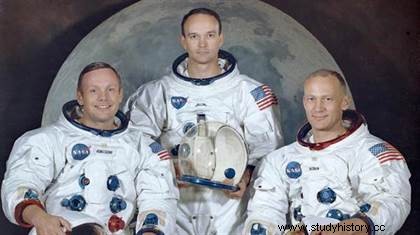 Neil Armstrong once flew on the Gemini 8 mission during which he showed remarkable coolness that probably saved the crew from disaster. His qualities will also prove invaluable for Apollo 11. Buzz Aldrin for his part piloted Gemini 12 during which three spacewalks were performed; he owes his presence in the group of mission "11" to the tragic death of the crew of Apollo 1. Michael Collins for his part took part in Gemini 10 , during which a very large number of scientific experiments were carried out.
Neil Armstrong once flew on the Gemini 8 mission during which he showed remarkable coolness that probably saved the crew from disaster. His qualities will also prove invaluable for Apollo 11. Buzz Aldrin for his part piloted Gemini 12 during which three spacewalks were performed; he owes his presence in the group of mission "11" to the tragic death of the crew of Apollo 1. Michael Collins for his part took part in Gemini 10 , during which a very large number of scientific experiments were carried out.
It is therefore a very experienced and perfectly trained team that leaves Earth orbit in the direction of the Moon, for three days of travel, which take place without incident. This is the third time that a human crew has placed itself in orbit around the Moon, and the maneuver is perfectly executed. After having stabilized its orbit during thirteen revolutions, the Apollo spacecraft splits in two:Michael Collins remains alone in the Command Module "Columbia " (name given in homage to Christopher Columbus as well as the novel From the Earth to the Moon by Jules Verne ), and Armstrong and Aldrin settle in the Lunar Module "Eagle "for the descent operation.
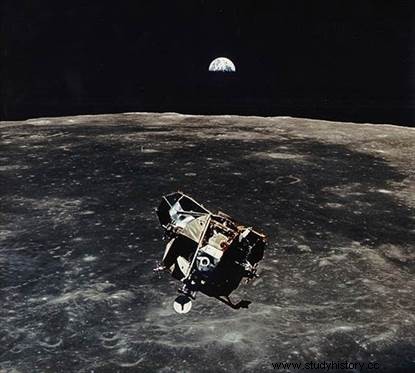 This maneuver has already been tested once (Apollo 10) but only partially; it first takes place as planned...until the appearance of two successive alarms unknown to the astronauts. It takes several minutes and the excellent memory of a NASA control center engineer, Steve Bales, to find the origin and make the decision to continue the mission. It is actually a memory saturation of the on-board computer and not a failure of a vital system. Armstrong, preoccupied by this alarm, forgets a final trajectory correction and unfortunately misses the site planned for the landing; he then decided to deactivate the autopilot to take control manually. This phase of the moon landing has been tested hundreds of times in simulation, during which the crew virtually crashed a very large number of times; succeeding this time, and for real, is absolutely not guaranteed. The lunar landscape is indeed riddled with craters of all sizes, not easy to spot and assess with the naked eye, and the fuel reserve is limited, adding a stress factor to the two astronauts.
This maneuver has already been tested once (Apollo 10) but only partially; it first takes place as planned...until the appearance of two successive alarms unknown to the astronauts. It takes several minutes and the excellent memory of a NASA control center engineer, Steve Bales, to find the origin and make the decision to continue the mission. It is actually a memory saturation of the on-board computer and not a failure of a vital system. Armstrong, preoccupied by this alarm, forgets a final trajectory correction and unfortunately misses the site planned for the landing; he then decided to deactivate the autopilot to take control manually. This phase of the moon landing has been tested hundreds of times in simulation, during which the crew virtually crashed a very large number of times; succeeding this time, and for real, is absolutely not guaranteed. The lunar landscape is indeed riddled with craters of all sizes, not easy to spot and assess with the naked eye, and the fuel reserve is limited, adding a stress factor to the two astronauts.
And it was at this critical moment that the extraordinary qualities of Neil Armstrong , Navy test pilot with unwavering composure and self-assurance make all the difference. It flies over calmly, and for very long seconds, an immense crater of the mother of tranquility , to land on board, just 20 seconds from running out of fuel. On the NASA side, everyone held their breath, and the words of the two space adventurers are a huge relief:“Houston, this is the base of Tranquility. The Eagle has landed…”.
The success of the Apollo 11 mission
Aldrin and Armstrong still have to carry out a series of checks and preparations to allow an emergency relaunch if necessary, then put on their suits and finally depressurize the LEM. The program conconted by the control of the mission plans to "walk on the moon", of course, but also to bring back rock samples, and to deploy a scientific station. And this is how on July 21, 1969 at 2:56 a.m. universal time, Neil Armstrong declared in front of a camera whose images were broadcast around the world:"It's a small step for a man, but a giant leap for humanity .
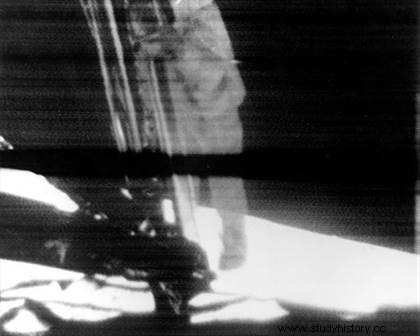 Buzz Aldrin joins him a few minutes later, and the two astronauts proceed to a spacewalk from a total of 2h31. They thus unveil a commemorative plaque attached to the foot of the LEM, specifying the intentions of this first exploration:"Here men from planet Earth first set foot on the Moon, July 1969 AD. We came in a peaceful spirit on behalf of all mankind."
Buzz Aldrin joins him a few minutes later, and the two astronauts proceed to a spacewalk from a total of 2h31. They thus unveil a commemorative plaque attached to the foot of the LEM, specifying the intentions of this first exploration:"Here men from planet Earth first set foot on the Moon, July 1969 AD. We came in a peaceful spirit on behalf of all mankind."
They then collect samples of regolith (the lunar rock) and lunar dust, put down the American flag (which will not resist the takeoff of the upper stage of the LEM, because planted too close) and install instruments, including a laser reflector which will make it possible to measure with precision the earth-moon distance. Armstrong also reportedly took the opportunity to place a bracelet in memory of his daughter Karen, who died at just two and a half years old following a brain tumor, at the bottom of a small crater, but he never did. confirmed.
A few hours after returning to the lunar module, and after a period of rest, the two astronauts successfully took off again and joined Michael Collins, who had remained in orbit, who for his part had been able to carry out many observations which will be used to identify the landing sites of the following Apollo missions. The return to earth goes smoothly, and after 21 days of quarantine, the three astronauts are celebrated as heroes in the United States and then in 23 countries during an unprecedented world tour.
Exploration of the lunar surface will continue for another 5 missions (Apollo 13 running short), during which the Americans will not stop perfecting their procedures, equipment and capability of exploration thanks in particular to the lunar rover. The last three missions of the initial program ("18", "19" and "20") will on the other hand be canceled for budgetary reasons; after having studied many extensions to the Apollo adventure, such as the establishment of a permanent base on the moon, or the manned trip to Mars, it is finally the reusable Space Shuttle project that will be retained.
50 years later, Neil Armstrong remains the symbol of one of the greatest feats in history and will forever remain as the first man to walk on the moon. He passed away on August 25, 2012...
Bibliography and useful links
- They Walked on the Moon:The Untold Account of the Apollo Explorations, by Philippe Henarejos
- The Conquest of Space for Dummies, by Michel Polacco
- From the Earth to the Moon, Apollo documentary series, Tom hanks
- First man - The first man on the Moon, book by James r. Hansen
- First Man - The First Man on the Moon, DVD / Bluray by Damien Chazelle.
